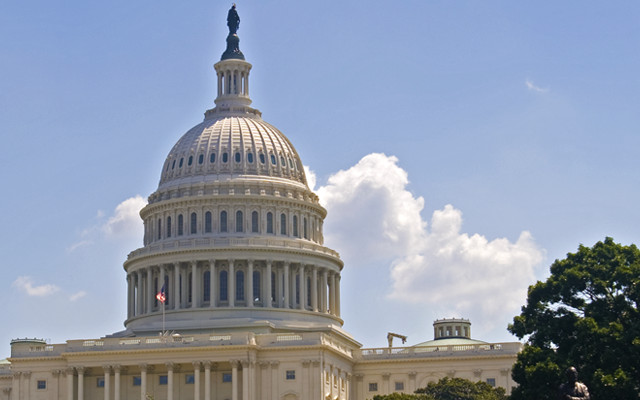
by Abby Seadler Tuesday, December 16, 2014
Politicians and pundits communicate with talking points. In Washington, D.C., a catchy sound bite often trumps a filibustering speech, and a grandiose idea must usually fit into only a few sentences. In science, however, communication occurs as dense journal articles or professional textbooks that flesh out complexities in minute detail. Bridging the gap between these two diverse communication styles in order to convey scientific issues to policymakers is the job of the American Geosciences Institute’s William L. Fisher Congressional Geoscience Fellows.
Each year, an accomplished scientist heads to Capitol Hill to use his or her expertise to help guide federal geoscience policy. The 2012-2013 fellow is Anna Henderson, who is currently serving as the Energy Fellow in the office of Sen. Al Franken of Minnesota.
Henderson received her doctorate in 2010 from the University of Minnesota. Her research focused on the use of oxygen and hydrogen isotope ratios preserved in ancient lake sediments to reconstruct changes in the seasonality of precipitation in Minnesota over the last 10,000 years, and relate ecosystem changes to water availability.
Initially, it was Henderson’s love of the outdoors that drew her to geoscience. In addition to conducting fieldwork in Minnesota, she has also collected data in Africa, Alaska, the Rocky Mountains, New England and at sea. However, she has now traded her hiking boots and lab coat for heels and a business suit to undertake the challenges of being a Congressional Science Fellow.
The fellowship program, founded in 1998, is a collaboration in which scientists — who spend the majority of their careers focusing on very specific topics — work together with policymakers, who spend the majority of their careers working on an array of broad issues. Whether there is a new bill being presented or a sudden change to an amendment, if it is related to science, it is Henderson’s responsibility as a science fellow to become an expert on that piece of legislation.
“I’m asked to find out what it means and to make a recommendation on how to vote,” she says.
Teasing apart the intricacies of a bill can be challenging. “It’s like a puzzle: I ask myself, what does a particular bill mean literally? What is its precedent? What are the pros and cons, and the arguments on either side of a bill?” she says.
Her responsibilities, however, do not end there. Henderson must also tactfully attempt to guide the attention of her office toward the most important issues. “You have to keep things focused: It’s not just suggesting ‘Ask this question’; it’s saying ‘Don’t spend too much time on this topic because you really need to get something else out of the meeting,’” she says.
Things are rarely black and white in politics, and Henderson must perform due diligence on each piece of legislation to understand and communicate the subtleties.
“For instance, on the surface it might seem like we should vote for a particular bill, but then when I actually dig into it, I realize the bill conflicts with where we stand on a certain issue,” she says.
Even after the implications of a scientific policy are uncovered, they are often difficult to communicate. Understanding the complicated subject matter and the technical language that frequently accompanies scientific issues often requires a great deal of background information.
“Sometimes you need a couple of details to get to the point of explaining why we should be thinking about a particular scientific topic,” she says. “But sometimes it’s hard to keep people’s attention while you convey those details in order to get to the critical information.”
Furthermore, when it comes to contentious issues like climate change, politics can get in the way of scientific facts.
“If you don’t have enough momentum in the House or Senate, then you can put out bills that serve as messages, but they aren’t going to get anywhere,” Henderson says. “The tricky thing is the balance between talking about the issue and promoting it, and keeping it alive. You don’t want to pour all your energy into places where it’s not going to go anywhere.”
For Henderson, however, communicating science in a way that everyone can understand comes naturally. After receiving her doctorate, she worked with fiction, nonfiction and poetry writers to develop programs to increase science literacy in creative outlets, an interest that goes back to her undergraduate days as a geology major at Brown University, where she received the Howard Hughes Science Writing Fellowship and an award for excellence in creative nonfiction.
Henderson views art and literature as access points for the general public to become interested in science. “Art is so accessible to everybody. And there’s really something very artistic and beautiful to minerals or even remote-sensing images.”
As science issues repeatedly come to the forefront of public debate, Henderson plans to continue to use her expertise and enthusiasm to communicate the importance of scientific issues to society.
“At any moment, I could be called on to do something that’s relevant and useful,” she says. “That is really exciting and stimulating, but it’s also a little nerve-wracking.”

Credit: Christopher M. Keane, Ph.D.
© 2008-2021. All rights reserved. Any copying, redistribution or retransmission of any of the contents of this service without the expressed written permission of the American Geosciences Institute is expressly prohibited. Click here for all copyright requests.